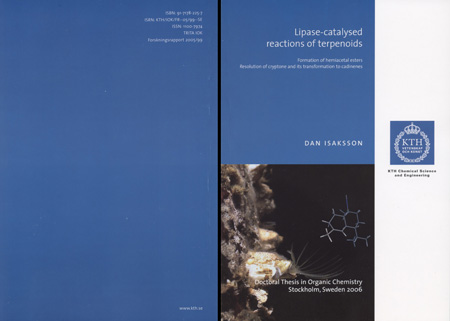My research
Last year (2006-01-27) I got my PhD degree in organic chemistry at KTH but my work has been located to the Mid Sweden University in Sundsvall. At present I am working at Chalmers in Gothenburg within the Marine paint project. Aiming to create an environmental friendly non-toxic antifouling paint
Summary of my work so far.
I started my research as an under graduate student doing my diploma work for my Master-degree in an ongoing research
project with the aim to extract and separate fine chemicals from TMP-turpentine. I began my PhD-studies within the
same project. The last three years of my PhD I turned to more synthetic work in order to synthesise some natural
products (sesquiterpenes).
Short background to the turpentine project:
The turpentine is produced as a side-product in the thermo mechanical pulping process (TMP-process) and is often used
as fuel to heat water used in the process. The thought with the project was to try and make something more valuable out of the turpentine
instead of just burn it as fuel. The turpentine collected in the TMP-process is classified as a ‘natural’ raw material.
If the methods to separate compounds from this turpentine is restricted to only mild conditions and natural methods
(e.g. chromatography, distillation, enzymatic and microbial methods) the resulting compounds can still be classified
as ‘natural’. This might be of interest for the food and perfume industry were natural raw material often bring a higher
value than synthetic equivalents. The turpentine contains many compounds of interest for this kind of industry.
The catch is how to separate them from the turpentine mixture.
Approach and methods:
The turpentine was fractionated using distillation and chromatography. This gave among other fractions on fraction of non-polar hydrocarbons and
one fraction of polar mostly oxygene functionalised monoterpenes. The content of the fractions were studied. My work was
to try and separate the enantiomers of the monoterpen alcohols in this mixture using lipase catlysed kinetic resolution.
Model systems with alcohols representative of the polar turpentine fraction was used in order to find lipases that would work.
Functionalised terpens is of higher value for the industry thus another goal for this project was to functionalise the hydrocarbon fraction using a cell culture from Spruce (Picea abies) and try to separate the products into pure fine chemicals. This work was performed together with a group in the Zech republic.
Results:
Unfortunately the selectivity in the lipase catalysed resolutions reactions was not satisfying and it proved difficult to
separate the enantiomers of the tested monoterpen alcohols using lipases. But during the studies we found that unexpected
side-products were formed. These findings and results are reported in the first two papers of my thesis.
The cell cultures indeed functionalised the monoterpens that were fed to it. I only did a minor part of this work and therefore
I did not include the two papers presenting this results in my thesis
Background to synthesis project:
I decided that I wanted to do some synthetic work as well in my PhD-time. Since my previous work have been with terpenes
and the fact that the organic research group have worked with pheromones I starting to look for a project that could combine
these two worlds. I ended up finding a lot of, from a biological and synthetic point of view, interesting sesqui- and di-terpens.
This group of compounds was mainly found in marine sponges and probably used as anitfoulants protecting the sponge. I chose
one of the compounds 10-isocyano-4-cadinene as synthetic target. It had previously been shown that this compound inhibited settling
of the barnacle Balanus amphitrite on immersed objects while being non-toxic for the barnacles at the active concentration. This
compound could thus be of interest as a component in a future non-toxic coating for submerged structures.
Approach to the synthesis of cadinenes:
We thought that cryptone would be a great starting material for this type of compounds. Therefore a synthetic route to
enantiomerically enriched cryptone was developed (Paper III in the thesis). Unfortunately the enantiomeric purity was not
good enough and a lipase catalysed resolution procedure was developed instead. (Paper IV in the thesis) I will not write
more about this project since it is still an ongoing one.
My publications.

Click the picture for a larger image of the cover. Download my thesis as a PDF file. |
My thesis is based on the following papers.
Paper I Paper II
Paper III
Paper IV
Appendix:
|
Papers not included in my thesis.
"Transformation of a-Pinene Using Picea abies Suspension Culture",
Lindmark-Henriksson M., Isaksson D., Sjödin K., Högberg H.-E., Vanek T., Valterová I., Journal of Natural products, 2003, 66, 237-243
Link to Journal of Natural Products.
"Transformation of terpenes using a Picea abies suspension culture",
Lindmark-Henriksson M., Isaksson D., Vanek T., Valterová I., Högberg H.-E. Sjödin K., Journal of Biotechnology, 2004, 107, 173-184
Link to Journal of Biotechnology.
Last updated 2007-02-03.
